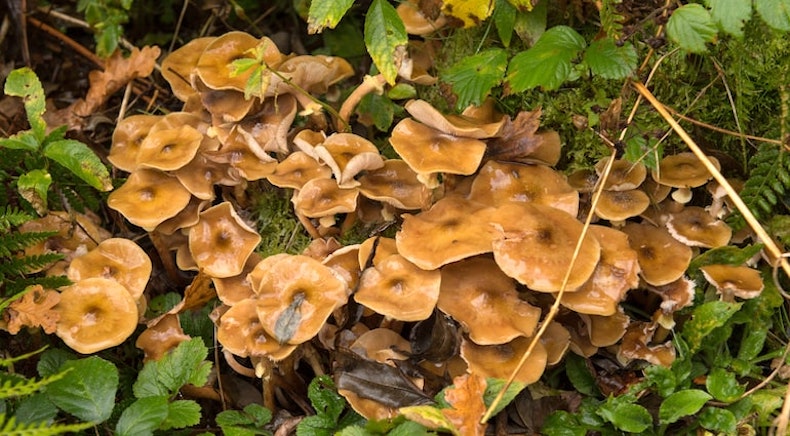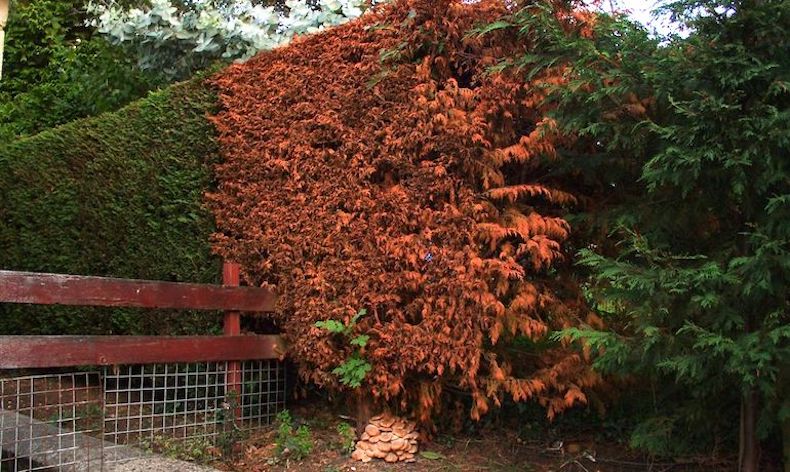Garden diseases - Honey Fungus

Honey fungus can devastate your garden
Image: Peter Turner Photography/Shutterstock
Honey fungus is one of the most destructive fungal diseases in UK gardens. It attacks the roots of perennial and woody plants underground, where it’s able to spread long distances.
What is honey fungus?

Honey fungus spreads through a network of black rhizomorphs
Image: Lairich Rig
Honey fungus is the name given to fungal infections in woody and perennial plants caused by the genus Armillaria.
The disease spreads underground through a network of rhizomorphs (black structures that look like roots or bootlaces) that can grow up to a metre every year. Honey fungus has also been known to infect plants as far as 30 metres from the original source of infection, hence its destructive reputation.
How to recognise honey fungus

Leaves going 'prematurely autumnal' can be a sign of honey fungus infection
Image: Tree Maintenance Ltd
Honey fungus causes sheets of white fungal growth to appear between the bark and wood of infected plants, usually close to ground level. You might also notice decaying roots and, if you dig down 15 - 45cm below soil level, you might locate the black rhizomorphs (but they are hard to find). Unfortunately, another indication of honey fungus is the sudden death of the plant.
Before this occurs, there are other symptoms to watch out for, including leaves that are smaller than normal and that change colour, either to a shade paler than normal or prematurely autumnal. Warning signs that the roots are under attack include the death of upper parts of the plant and a failure to flower. Some plants may even experience a particular heavy flowering and abundance of fruit.
During the autumn months, honey-coloured toadstools may appear. However, these are just an indicator of infection and aren’t dangerous themselves, as the spores don’t play a role in the disease’s life cycle. But if you notice any of the other symptoms, don’t wait until toadstools appear to make the final diagnosis. The disease may spread dramatically before the toadstools grow.
How to treat honey fungus
If you detect a honey fungus infection in your garden the most effective way to control its spread and prevent further outbreaks is to excavate and destroy all infected plant material, and create physical barriers underground to stop the progress of any remaining rhizomorphs.
Make sure to completely remove all infected plant material, including the whole root system, the stump, and any fallen leaves. Depending on the size of infected plants, you may require professional help. All plant material should then be burned and your tools disinfected.
How to prevent honey fungus

Create a physical barrier between the affected and unaffected areas
Image: MH Landscape
The disease requires infected material to feed upon, so once the food source is removed, you can work to protect the rest of your garden. Install a protective barrier between the unaffected and affected plants, such as pond lining or heavy duty plastic. The barrier should be at least 45cm deep and extend about 2-3cm above soil level. This will block the spread of any remaining rhizomorphs and prevent further infection. Regularly digging the affected soil will break them up.
To prevent any further outbreaks, avoid planting anything in the site of previous infection. You may also prefer to plant species that are less affected by the disease, such as black walnut, box elder, jasmine, beech, yew and holm oak.
Other pages you might like
See all pests & diseases guides
Individual guides
Diseases
- Apple scab
- Bacterial canker
- Blackleg
- Blossom wilt
- Botrytis
- Brown rot
- Clematis wilt
- Downy mildew
- Fungal disease
- Leaf scorch
- Leaf spot
- Leek rust
- Lily disease
- Peach leaf curl
- Pear rust
- Phytophthora root rot
- Potato & tomato blight
- Powdery mildew
- Silver leaf fungus
- Tomato greenback
- Tomato leaf curl
- Tomato stem canker







